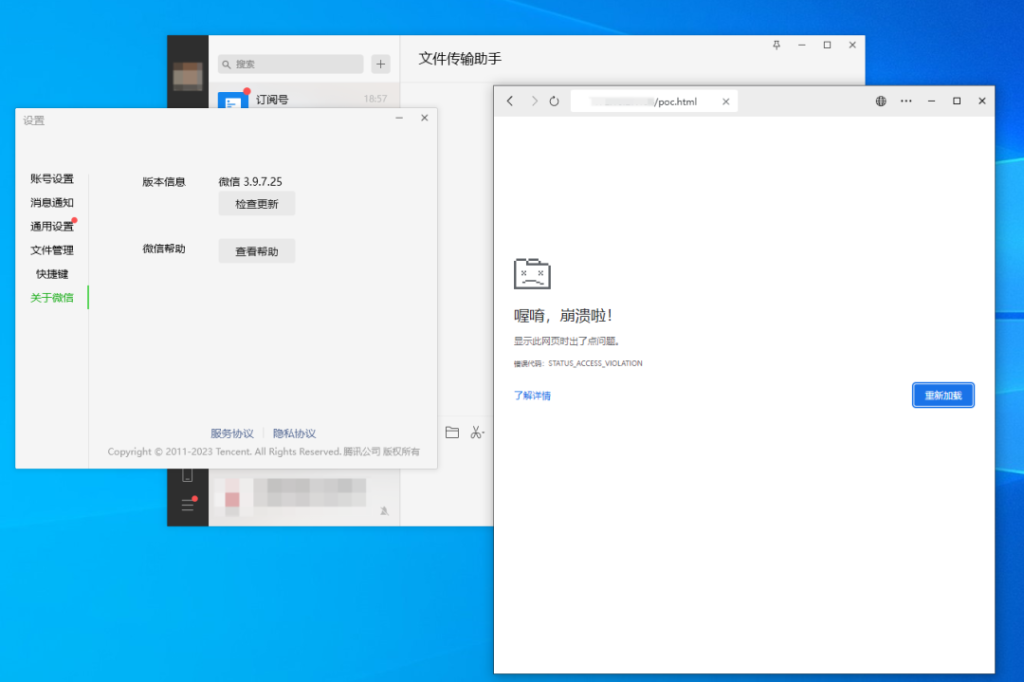
Instant messaging (IM) applications like WeChat have become indispensable for billions, facilitating not only communication but also payments, business, and personal data exchange.
However, their ubiquity and complexity make them prime targets for sophisticated cyberattacks.
This article explores how a single WeChat message can be leveraged for persistent client-side attacks, examining the technical mechanisms, real-world vulnerabilities, and WeChat’s layered security responses.
Attack Surfaces in WeChat:
WeChat’s client-side architecture exposes several critical attack surfaces:
- URL Links and Custom Protocols: WeChat supports custom URI schemes such as
weixin://, enabling deep linking within the app. - Attackers can exploit lax URL validation to craft malicious links, potentially redirecting users to phishing sites or triggering sensitive in-app actions without consent.
- For example, the
weixin://dl/protocol is used for page routing, and URLs containing theticketparameter invoke the/cgi-bin/mmbiz-bin/translatelinkendpoint to resolve destinations, mitigating arbitrary redirects. - File Processing Vulnerabilities: WeChat’s custom file handling logic, designed for user convenience, can be exploited by attackers using specially crafted files.
- Notable vulnerabilities include CVE-2019-11932 (malicious GIF in WhatsApp) and CVE-2025-30401 (executable disguised as an image), both of which enabled remote code execution in IM clients1.
- Built-in Browser Components: WeChat’s Android client uses the XWEB engine, a Chromium-based browser.
- While XWEB is regularly updated, it often lags behind official Chrome releases, leaving it exposed to known vulnerabilities like CVE-2023-41064 and CVE-2023-4863 in the
libwebpcomponent. - The JSBridge interface, which allows web pages to invoke native functions, is tightly controlled by a permission array fetched from the cloud, limiting access based on the webpage’s URL.

| Attack Surface | Example Protocol/Component | Vulnerability Type | Mitigation Mechanism |
|---|---|---|---|
| URL Links | weixin://, slack://settings |
Phishing, Unauthorized Actions | Strict URL validation, domain whitelisting |
| File Processing | GIF, Executable disguised as image | Remote Code Execution | File type validation, sandboxing |
| Built-in Browser | XWEB, JSBridge | Privilege Escalation, RCE | Permission arrays, process isolation |
| Mini-Programs | JavaScript APIs | XSS, Privilege Abuse | Dual-layer isolation, JSAPI controls |
Technical Mechanisms and Security Codes
WeChat URL Validation:
To prevent configuration tampering, WeChat restricts sensitive operations like set_config_url to HTTPS domains dldir1.qq.com or dldir1v6.qq.com only. For example:
textif (protocol != "https" || (domain != "dldir1.qq.com" && domain != "dldir1v6.qq.com")) {
rejectRequest();
}
This strict validation ensures that even if a user is tricked into clicking a malicious link, unauthorized configuration changes are blocked.
Process Isolation in XWEB:
WeChat’s XWEB browser employs multi-process sandboxing:
- The main process runs in
xweb_privileged_process_0 - Rendering occurs in
xweb_sandboxed_process_0
This separation limits the impact of rendering process vulnerabilities, making privilege escalation significantly harder for attackers.
Mini-Program Security Architecture:
WeChat mini-programs split execution into a rendering layer (UI) and a logic layer (business logic), each running in isolated threads.
JavaScript code in the logic layer cannot access DOM APIs, while the rendering layer cannot invoke high-privilege functions. Key JSAPI functions are exposed selectively:
| Layer | Example JSAPI Functions |
|---|---|
| Rendering Layer | insertVideoPlayer, insertTextArea |
| Logic Layer | saveFile, addDownloadTask |
This architecture prevents attackers from using cross-site scripting (XSS) in mini-programs to escalate privileges or access sensitive APIs.
Best Practices and Remaining Challenges
Despite these robust mechanisms, WeChat’s security is not without flaws:
- Cryptographic Weaknesses: WeChat’s MMTLS protocol, a modified version of TLS 1.3, contains cryptographic weaknesses such as deterministic IVs and lack of forward secrecy, making it less secure than standard implementations.
- Code Obfuscation for Mini-Programs: To counter reverse engineering, WeChat mini-programs can employ code obfuscation, anti-debugging, and encryption of HTML/JavaScript. This increases the difficulty for attackers attempting to extract proprietary algorithms or sensitive data.
Managing Token Permissions
WeChat provides server-side interfaces setCloudAccessToken to manage cloud token permissions, ensuring only authorized components can access sensitive APIs.
In summary, WeChat’s multi-layered security—spanning strict URL validation, process isolation, dual-thread mini-program architecture, and permission-based API exposure—demonstrates a comprehensive approach to mitigating persistent client-side attacks.
However, continued vigilance and adoption of cryptographic best practices remain essential as attackers evolve their methods.
Find this News Interesting! Follow us on Google News, LinkedIn, & X to Get Instant Updates!



.png
)
